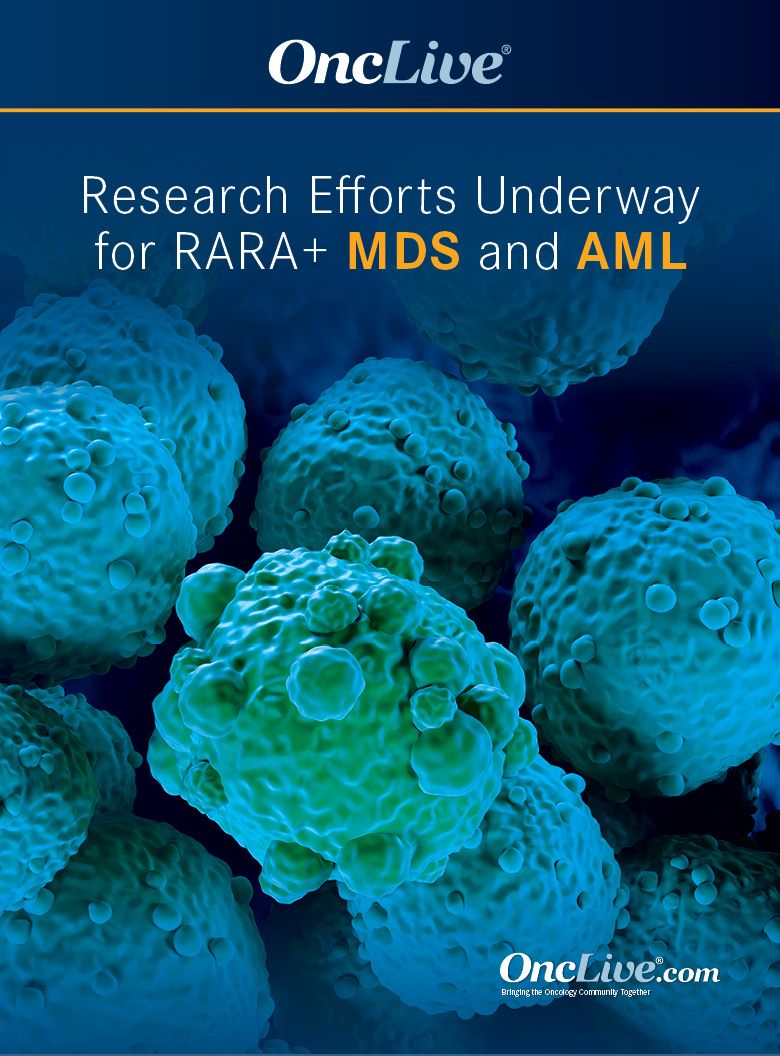Publication
Article
Tamibarotene, Azacitidine, and Venetoclax May Strengthen AML Armamentarium
Author(s):
Brian Ball, MD, discusses the significance of targeting RARA in AML, the rationale for SELECT-AML-1, and additional AML research that may contribute to the broadening treatment paradigm in the future.
Brian Ball, MD

The investigative combination tamibarotene plus azacitidine (Vidaza) and venetoclax (Venclexta) may be more tolerable than standard-of-care (SOC) azacitidine and venetoclax alone, thus addressing an unmet need in patients with monocytic acute myeloid leukemia (AML) who are unfit for intensive chemotherapy, according to Brian Ball, MD.
Previously, the phase 2 SY-1425-201 trial (NCT02807558) evaluated the efficacy and safety of tamibarotene, a selective retinoic acid receptor alpha (RARA) inhibitor, plus azacitidine in patients with newly diagnosed AML who were unfit for intensive chemotherapy. In this trial, the patients with RARA-positive disease had an overall response rate (ORR) of 67%, with 61% of patients achieving a complete response (CR) and 6% of patients achieving a morphologic leukemia-free state. The patients with RARA-negative disease had an ORR of 39% and a CR rate of 29%.1
Now, the ongoing phase 2 SELECT-AML-1 trial (NCT04905407) will randomly assign patients with previously untreated, newly diagnosed, RARA-positive AML who are ineligible for standard induction therapy to receive azacitidine and venetoclax with or without tamibarotene. Part 1 of this trial will evaluate the safety and tolerability of these regimens, with ORR as a key secondary end point. Part 2 will evaluate CR/CR with incomplete count recovery (CRi) rate with key secondary end points including duration of CR/CRi, time to CR/CRi, ORR, and safety. This trial is currently enrolling.2
“This is a great trial that should be considered for all newly diagnosed patients who are elderly or unfit for intensive chemotherapy,” Ball said.
In an interview with OncLive®, Ball discussed the significance of targeting RARA in AML, the rationale for SELECT-AML-1, and additional AML research that may contribute to the broadening treatment paradigm in the future.
Ball is an assistant professor in the Division of Leukemia in the Department of Hematology & Hematopoietic Cell Transplantation at City of Hope in Duarte, California.
OncLive: What treatment challenges exist for patients with AML, and what unmet needs in this population are ongoing efforts trying to address?
Ball: We have several challenges and unmet needs in the management of AML. Certain high-risk groups remain a problem for us. Patients with p53 mutations have poor outcomes with standard induction chemotherapies and other lower-intensity therapies. Patients with other adverse cytogenetic or molecular features, such as inv(3), remain a problem.
Other unmet challenges remain. Patients who have progressed on frontline regimens, and patients who’ve progressed on venetoclax and azacitidine, have poor outcomes. [Their] rates of median survival have been reported to be around 3 months. This population is a focus of many clinical trials because it has a significant unmet need.
What is the rationale for targeting RARA in patients with AML, and what proportion of patients with AML are RARA positive?
Retinoic acid receptor genes have been important in acute promyelocytic leukemia [APL], where targeting of all-trans retinoic acid [ATRA], as well as arsenic trioxide, is curative for those patients. A comprehensive, large chromatin and gene expressive analysis found that there’s a certain subset of patients with non–acute promyelocytic AML who have expression of retinoic acid receptor genes. That led to looking into if these APL treatments, such as ATRA, are active in this subset of AML with RARA pathway activation.
They found that tamibarotene demonstrated activity in AML cell lines and in patient-derived AML mouse models. In addition, the drug led to differentiation of the leukemic blasts. This led to clinical trials targeting these retinoic acid receptor–dependent AML blasts with tamibarotene in combination with azacitidine.
About 20% of patients with AML have activation of the retinoic acid receptor pathway. This subset of AML happens to be enriched for characteristics associated with resistance to venetoclax. For example, a significant percentage of these types of patients have monocytic-type AML, which is a type of AML that does not respond as well to frontline venetoclax and azacitidine.
What is the unique mechanism of action of tamibarotene that differentiates it from other agents under exploration?
This is an interesting drug in that it’s an oral agent that is more potent than ATRA. We have good safety data with it. It’s been approved in certain countries like in Japan, for example, for APL. Tamibarotene is a next-generation oral RARA agonist which induces expression of retinoic acid response genes, leading to differentiation of non–acute promyelocytic AML with high RARA expression.
The SY-1425-201 trial investigated tamibarotene plus azacitidine in patients with AML or myelodysplastic syndrome (MDS). What key findings from that study led to the SELECT-AML-1 trial?
The key finding from that trial is that this is a tolerable drug. The regimen was well tolerated, and it did not seem to increase toxicity above azacitidine baseline toxicities. As far as preliminary efficacy, the results of tamibarotene and azacitidine alone seemed similar to venetoclax and azacitidine, so CR rates of 61% [in RARA-positive patients].
SELECT-AML-1 will evaluate tamibarotene plus venetoclax and azacitidine in patients with newly diagnosed AML. What is the rationale for adding tamibarotene to the venetoclax/azacitidine combination?
Venetoclax in combination with azacitidine is now the new SOC for patients with newly diagnosed AML who are elderly or unfit for intensive chemotherapy. By adding tamibarotene, we’re trying to see if we can improve upon this SOC.
What excites me about the addition of tamibarotene to this regimen is that since it induces differentiation, it may mitigate some of the cytopenias we see with venetoclax and azacitidine. There’s excitement that this may make the venetoclax and azacitidine regimen more tolerable regarding the cytopenias and may increase its efficacy in patient populations that normally do not respond to the venetoclax and azacitidine regimen.
What are the key eligibility criteria for SELECT-AML-1?
The key eligibility criteria are similar to those for other AML clinical trials for newly diagnosed elderly and unfit patients. In addition to those criteria, patients must have RARA expression. They must complete prescreening, where peripheral blood is collected and sent to a central lab, to determine if they meet eligibility for the RARA pathway biomarker.
What other ongoing trials within AML could help address other unmet needs for these patients?
The biggest unmet need in our field is in patients with TP53 mutations or TP53 abnormalities. One of the most promising regimens we’ve seen that’s under investigation would be magrolimab in combination with azacitidine or venetoclax and azacitidine. [That agent] may be a benefit to this population. We’ve seen in MDS that magrolimab and azacitidine seems to lead to similar CR rates for patients with TP53-mutated disease and those who don’t have TP53-mutated disease. There is some excitement that this may be a benefit to those very high-risk patients.
The other promising therapy is menin inhibitors. Patients with KMT2A rearrangements or high-risk NPM1 mutations can have poor outcomes. KMT2A rearrangements are associated with having prior exposure to chemotherapy and [patients in this] population [have] therapy-related AML. Patients [with KMT2A rearrangements] have poor outcomes after transplant. [These rearrangements are] associated with a risk of relapse and shorter long-term survival after transplant.
The development of menin inhibitors is a game changer for this population. We’ve seen high and deep CR rates and deep minimal residual disease–negative remission rates. This therapy is promising in combinations and in the post-transplant maintenance setting to potentially cure more patients with this high-risk disease subtype.
What is your main message for colleagues regarding the investigation of tamibarotene in the SELECT-AML-1 trial?
This agent should be strongly considered for clinical trials and for patients with newly diagnosed AML. It potentially addresses an unmet need in improving outcomes for patients with monocytic AML. As a differentiation agent, we may find that it makes the [azacitidine/venetoclax] regimen more tolerable. It has the potential to change the SOC.
References
- De Botton S, Cluzeau T, Vigil CE, et al. SY-1425, a potent and selective RARα agonist, in combination with azacitidine demonstrates a high complete response rate and a rapid onset of response in RARA-positive newly diagnosed unfit acute myeloid leukemia. Blood. 2020;136(suppl 1):4-5. doi:10.1182/blood-2020-134600
- Tamibarotene plus venetoclax/azacitidine in participants with newly diagnosed AML. ClinicalTrials.gov. Updated April 24, 2023. Accessed April 24, 2023. https://clinicaltrials.gov/ct2/show/NCT04905407










